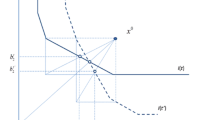Abstract
This paper designs a Malmquist productivity index (MPI) to measure the productivity change of a decision-making unit (DMU) on a specific input/output factor over time. First, factor-specific data envelopment analysis is extended by considering input/output substitution possibilities, where partial correlation is taken as the criterion of substitutability. Factors are clustered and those which are not in the same cluster with the concerned one are excluded when calculating the factor-specific efficiency. Next, the common weights global MPI is employed, in order to simultaneously have the sound properties of consistency, circularity and comparability. Common weights are generated separately for each DMU, since only the productivities of a same DMU at different periods need to be compared in the calculation process of MPI. The case of Taiwan forests after reorganization illustrates that the proposed models can provide new insights into the productivity change of DMUs.
Similar content being viewed by others
References
Adler N, Golany B (2001) Evaluation of deregulated airline networks using data envelopment analysis combined with principal component analysis with an application to Western Europe. Eur J Oper Res 132(2):260–273
Adler N, Golany B (2002) Including principal component weights to improve discrimination in data envelopment analysis. J Oper Res Soc 53(9):985–991
Adler N, Yazhemsky E (2010) Improving discrimination in data envelopment analysis: PCA–DEA or variable reduction. Eur J Oper Res 202(1):273–284
Banker RD, Morey RC (1986) Efficiency analysis for exogenously fixed inputs and outputs. Oper Res 34(4):513–521
Bi GB, Ding JJ, Luo Y, Liang L (2011) A new malmquist productivity index based on semi-discretionary variables with an application to commercial banks of china. Int J Inf Technol Decis Mak 10:713–730
Caves DW, Christensen LR, Diewert WE (1982a) Multilateral comparisons of output, input, and productivity using superlative index numbers. Econ J 73–86
Caves DW, Christensen LR, Diewert WE (1982b) The economic theory of index numbers and the measurement of input, output, and productivity. Econom: J Econom Soc 393–1414
Chang H, Choy HL, Cooper WW, Ruefli TW (2009) Using Malmquist Indexes to measure changes in the productivity and efficiency of US accounting firms before and after the Sarbanes–Oxley Act. Omega-Int J Manag Sci 37:951–960
Charnes A, Cooper WW, Rhodes E (1978) Measuring the efficiency of decision making units. Eur J Oper Res 2:429–444
Chen Y (2003) A non-radial Malmquist productivity index with an illustrative application to Chinese major industries. Int J Prod Econ 83:27–35
Cooper WW, Seiford LM, Zhu J (2011) Handbook on data envelopment analysis. 164, Springer
Dyson RG, Allen R, Camanho AS, Podinovski VV, Sarrico CS, Shale EA (2001) Pitfalls and protocols in DEA. Eur J Oper Res 132(2):245–259
Färe R, Grosskopf S, Lindgren B, Roos P (1992) Productivity changes in Swedish pharamacies 1980–1989: a non-parametric Malmquist approach. J Prod Anal 3(1):85–101
Färe R, Grosskopf S, Norris M, Zhang Z (1994) Productivity growth, technical progress, and efficiency change in industrialized countries. Am Econ Rev 66–83
Ferrier GD, Valdmanis VG (2004) Do mergers improve hospital productivity? J Oper Res Soc 55:1071–1080
Foroughi AA (2012) A modified common weight model for maximum discrimination in technology selection. Int J Prod Res 50(14):3841–3846
Jenkins L, Anderson M (2003) A multivariate statistical approach to reducing the number of variables in data envelopment analysis. Eur J Oper Res 147(1):51–61
Kao C (2000) Measuring the performance improvement of Taiwan forests after reorganization. For Sci 46:577–584
Kao C (2010) Malmquist productivity index based on common-weights DEA: the case of Taiwan forests after reorganization. Omega-Int J Manag Sci 38:484–491
Kao C, Hung HT (2005) Data envelopment analysis with common weights: the compromise solution approach. J Oper Res Soc 56:1196–1203
Kao C, Yang YC (1992) Reorganization of forest districts via efficiency measurement. Eur J Oper Res 58:356–362
Karsak EE, Ahiska SS (2005) Practical common weight multi-criteria decision-making approach with an improved discriminating power for technology selection. Int J Prod Res 43:1537–1554
Karsak EE, Ahiska SS (2008) Improved common weight MCDM model for technology selection. Int J Prod Res 46(24):6933–6944
Malmquist S (1953) Index numbers and indifference surfaces. Trabajos de Estadistica y de Investigacion Operativa 4(2):209–242
Nataraja NR, Johnson AL (2011) Guidelines for using variable selection techniques in data envelopment analysis. Eur J Oper Res 215:662–669
Odeck J (2006) Identifying traffic safety best practice: an application of DEA and Malmquist indices. Omega-Int J Manag Sci 34:28–40
Oliveira MM, Gaspar MB, Paixao BJP, Camanho AS (2009) Productivity change of the artisanal fishing fleet in Portugal: a Malmquist index analysis. Fish Res 95:189–197
Pastor JT, Lovell CA (2005) A global Malmquist productivity index. Econ Lett 88(2):266–271
Thanassoulis E, Dyson RG (1992) Estimating preferred target input–output levels using data envelopment analysis. Eur J Oper Res 56(1):80–97
Tofallis C (1997) Input efficiency profiling: an application to airlines. Comput Oper Res 24(3):253–258
Tohidi G, Razavyan S (2013) A circular global profit Malmquist productivity index in data envelopment analysis. Appl Math Model 37:216–227
Tone K (2001) A slacks-based measure of efficiency in data envelopment analysis. Eur J Oper Res 130:498–509
Ueda T, Hoshiai Y (1997) Application of principal component analysis for parsimonious summarization of DEA inputs and/or outputs. J Oper Res Soc Jpn-Keiei Kagaku 40(4):466–487
Vaz CB, Camanho AS (2012) Performance comparison of retailing stores using a Malmquist-type index. J Oper Res Soc 63:631–645
Xue XL, Shen QP, Wang YW, Lu JF (2008) Measuring the productivity of the construction industry in China by using DEA-based Malmquist productivity indices. J Constr Eng Manag Asce 134:64–71
Zhu J (2000) Multi-factor performance measure model with an application to Fortune 500 companies. Eur J Oper Res 123:105–124
Acknowledgments
The authors would like to thank the anonymous referees for their constructive comments which substantially improved the first version of this paper.
Author information
Authors and Affiliations
Corresponding author
Rights and permissions
About this article
Cite this article
Yang, B., Zhang, Y., Zhang, H. et al. Factor-specific Malmquist productivity index based on common weights DEA. Oper Res Int J 16, 51–70 (2016). https://doi.org/10.1007/s12351-015-0185-x
Received:
Revised:
Accepted:
Published:
Issue Date:
DOI: https://doi.org/10.1007/s12351-015-0185-x




